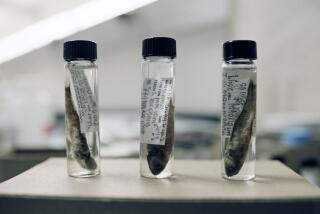DDT’s toxic legacy can harm granddaughters of women exposed, study shows
When Rachel Carson’s “Silent Spring” first sounded the alarm on DDT and its devastating effects on birds and fish, our understanding of how this pesticide affected humans was just beginning. Chemicals can take years to reveal their insidious power, and so for decades, scientists have been piecing together — study by study — the reasons why DDT still haunts us today.
First it was breast cancer in women who were exposed to this hormone-disrupting chemical in the 1950s and ‘60s. Then their daughters, who had been exposed in the womb. Researchers over the years have also linked DDT exposure to obesity, birth defects, reduced fertility and testicular cancer in sons.
Now, a team of toxicologists, molecular biologists and epidemiologists at UC Davis and the Public Health Institute in Oakland have confirmed for the first time that granddaughters of women who were exposed to DDT during pregnancy also suffer from significant health threats: Higher rates of obesity and menstrual periods that start before age 11.
Both factors, scientists say, may put these young women at greater risk of breast cancer — as well as high blood pressure, diabetes and other diseases.
“This is further evidence that not only is a pregnant woman and her baby vulnerable to the chemicals that she’s exposed to — but so is her future grandchild,” said Barbara Cohn, director of the Public Health Institute’s Child Health and Development Studies, a multigenerational research project in California that has followed more than 15,000 pregnant women and their families since 1959.
“This is something that people had always thought was possible,” she said, “but there had never been a human study to support the existence of that link.”
The findings come at a time of renewed public interest in DDT, a problem that had been largely tucked into a fading chapter of history. Concerns have intensified since The Times reported last fall that the nation’s largest manufacturer of DDT once dumped as many as half a million barrels of its waste into the deep ocean.
The pesticide, now banned, is so stable it continues to poison the environment and move up the food chain. Significant amounts of DDT-related compounds are still accumulating in Southern California dolphins, and a recent study linked the presence of these persistent chemicals to an aggressive cancer in sea lions.
As for humans, “there’s a clear line you can track of what’s happening,” said Linda Birnbaum, who, as the former director of the National Institute of Environmental Health Sciences and the National Toxicology Program, has been following these multigenerational studies with great interest.
“A lot of people want to think that the problems with DDT have gone away, because Congress banned it in 1972. Well, they haven’t,” said Birnbaum, who is now a scholar in residence at Duke University. “By the time the daughters got pregnant with the granddaughters, that was long after DDT had been banned — and yet they were carrying within them the seeds of these problems.”
::
More than 60 years ago, in the heyday of DDT, a team of scientists had the foresight to start collecting blood samples from more than 15,000 pregnant women at the Kaiser Permanente hospital in Oakland. At every trimester and also shortly after birth, each woman provided a sample that was studied and carefully archived.
Researchers tested the blood for DDT, dichlorodiphenyltrichloroethane, and continued to follow up on health assessments. They kept in touch with the women’s daughters, who had been exposed to DDT in the womb, and then with their granddaughters.
They found, after years of research, that women heavily exposed to DDT during childhood are five times as likely to develop breast cancer, and that a mother’s DDT exposure during pregnancy, or immediately after birth, is linked to an increased risk of breast cancer for their daughter. Their daughters are also more likely to experience delays in getting pregnant.
In this most recent study, published Wednesday in the journal Cancer Epidemiology, Biomarkers & Prevention, the research team found that the risk of obesity in the granddaughters — who are now in their 20s and 30s — was two to three times greater than women whose grandmothers had little DDT in their blood during pregnancy. These granddaughters were also twice as likely to have much earlier menstrual periods — another indicator of increased health risks later in life.
This persistent, generational exposure is likely related to the reproductive system, Cohn said. Since a female is born with all her eggs, a granddaughter is technically also exposed to DDT if her mother was exposed in the womb.
“Even though we banned that stuff more than 40 years ago, people now walking the Earth — the granddaughters of those who were pregnant — were exposed,” Cohn said. She wonders if the increasing rates of childhood cancer, diabetes and other health problems affecting young people today are also somehow connected to these chemicals of the past. “It’s the full meaning of what a ‘forever chemical’ is — in some ways, that makes every chemical potentially ‘forever’ if it has the potential to do this.”
Scientists found that sea lions exposed to DDT and other chemicals in the ocean are more likely to die from a herpes-induced cancer.
Bruce Blumberg, a professor of developmental and cell biology at UC Irvine, still remembers the trucks that used to spray massive amounts of DDT in farms and neighborhoods. At the supermarket where he worked as a kid, foggers would be brought inside at the end of each day.
“The whole market would be full of a fog of DDT,” said Blumberg, who also teaches pharmaceutical sciences. “The industry would want you to believe that chemicals have no effect, because the doses are too low and there’s just no effects and it’s all crazy alarmists.”
Blumberg now specializes in studying how chemicals in the environment can affect our genes and predispose people to obesity, which affects about 42% of Americans today. He conducts lab experiments on mice to answer the many questions that scientists have been unable to test on humans.
That’s why the multigenerational Bay Area study, which he’s not affiliated with, is so important, he said. It provides much-needed human observational data that are incredibly hard to come by — perhaps even harder to maintain.
“If we’re lucky, that cohort [of Bay Area women] will continue through four, five, six generations,” he said, “and we’ll really learn something about the effects of what happened in the past on the future.”
::
Akilah Shahid said she was shocked, yet fascinated, to learn that she was in the third generation of a major study on how chemicals in the environment could be affecting women.
A biology major at Mills College, Shahid said it all clicked for her for when she dug into the research. Her family has been no stranger to health problems. Her grandmother alone has fought cancer three times.
“I feel like, for a while, cancer just came out of nowhere,” she said. “You don’t know who’s going to get it, and now we have a reason why.”
Shahid, now 30, exercises a lot. She tries to eat well. It empowers her to know that her weight isn’t completely her fault — and that there’s only so much within her control.
DDT isn’t allowed anymore, but she can’t help but wonder about all the other chemicals still prevalent today — bisphenol A (BPA), per-and polyfluoroalkyl substances (PFAS) and other manufactured compounds that don’t seem to ever go away. She avoids plastic water bottles and tries to be mindful of how her choices and actions right now could expose her future grandchildren to some unknown disease.
“How many times have we talked about climate change and things that we need to do better for our children and grandchildren? This is more proof that hello, what we do today is going to affect people way forward,” she said.
“I hope this is a wake-up call for a lot of people, because we’re talking about saving the environment again, today, for our future generations.”







